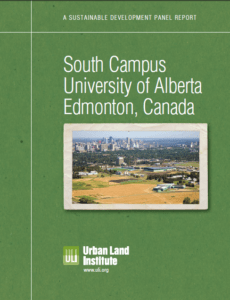Top Story
Location: Edmonton, Canada
Sponsor: The University of Alberta, Alberta Energy, and Alberta Environment
Chair: Alex J. Rose
Subject Area: Regional Growth and Planning, Economic Growth and Development
Download Panel Report (1200 KB)
The Panel’s Assignment
The university is preparing plans for further development of the South Campus as an academic center in addition to its current use as an agricultural research station and the location of several large sports and physical education and recreation facilities, some of which are shared with the city of Edmonton and organized city groups. All of the sponsors are interested in the South Campus becoming a leading example of sustainable institutional and community development that can be a model for other Alberta institutions and communities. In addition, the university seeks detailed advice on the appropriateness and sufficiency of the current planning activities. In developing a model of sustainability for the South Campus, the university is looking for best practices, measures, and standards that are transferable to other communities and institutions in Alberta. The ULI panel has been asked to address the following questions:
- Outline the rationales for and against developing a sustainable South Campus community that should guide the university in its planning and implementation, including the triple-bottom line and balanced-scorecard approaches. How would the University of Alberta and the university community benefit from a sustainable campus, and how would it address any risks that the university would face by moving away from conventional practices?
- Define what a world-leading sustainable campus would look like in the northern climatic region. Describe the infrastructure, integrated energy system and building standards, technologies, and best practices that should be implemented.
- Will the current draft Concept Plan and the current work program lead to the model sustainable campus the university desires? What, if any, additional work is required?
- Are changes in design, construction, and operational practices required to ensure that sustainability is achieved and maintained for the life of the South Campus? Please describe them.
- The University of Alberta is proposing to host a World Expo in 2017. The legacy of the Expo for the university will be South Campus infrastructure and buildings. What other alternative development funding models (e.g., P3) are available and appropriate to achieve the development of a model sustainable campus?
- How can the South Campus be successfully integrated with and contribute to the vitality of the surrounding communities and activity areas without significantly affecting research and teaching activities?
- What metrics and benchmarks should the university use to measure sustainability of the South Campus? How should the metrics evolve over time?
- How can the South Campus energy system be sustainably integrated within Alberta’s competitive electricity and natural gas markets and industry structure?
For a team of economists, planners, designers, consultants, and developers, the level of challenge is increased by a temporal consideration. Panelists often think of planning and executing projects in terms of years or even multiple decades. Applying the panelists’ skills and experience to a plan and an environment that will span generations, if not into perpetuity, is a far more challenging task.
At the same time, the clarity of the vision of the university—daring to discover—and its commitment to execution—daring to deliver—coupled with the panel’s systematic way of looking at the challenge before it, have yielded a responsive set of findings and recommendations and, the panel believes, a roadmap for the way forward.
Summary of the Panel’s Observations
The panel had the following observations that acted to frame their recommendations and conclusions in this report:
- The Edmonton market and economy present the university with an array of economic drivers that can and will significantly shape and facilitate execution of the university’s long-range plans.
- The combination of the university’s agricultural and scientific research heritage, coupled with its unique landholdings, facilitates the implementation of a wide variety of sustainability measures.
- Far more than just another Leadership in Energy and Environmental Design (LEED) building or an energy-efficient building system, the university’s culture of discovery, research, interdisciplinary academics, and partnering with government and industry provides the opportunity to take a global leadership role in creating significant sustainable measures—enhancing the entire University of Alberta campus environmentally, socially, and economically.
- The university’s South Campus, West 240, and related holdings represent much more than just additional land for future university growth—both known and, at least today, somewhat immeasurable. A model of community, in the broadest sense of that word, is clearly within reach and, at the same time, is one that will emerge, evolve, and change over many decades and several generations to come.
- These great opportunities—benefiting from the market, advancing sustainability, growing the influence and leadership of the university as well as its physical presence—must come as the result of a plan: not just a diagram of land use, but a comprehensive assessment of what the university is, what it wants to be, and how it plans to get there.
This is a long, thoughtful, detailed, collaborative, iterative process—again, the very characteristics of discovery and problem solving exhibited by the university every single day.
